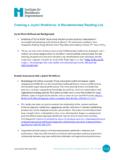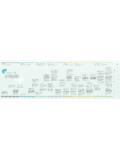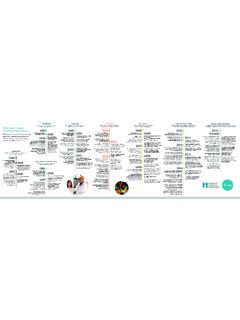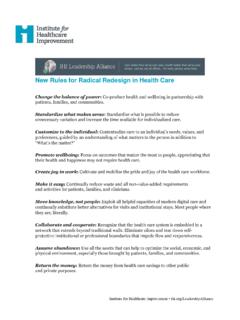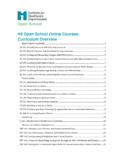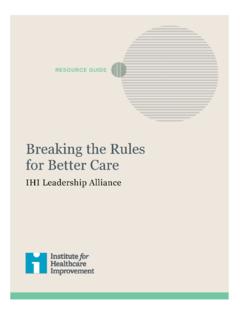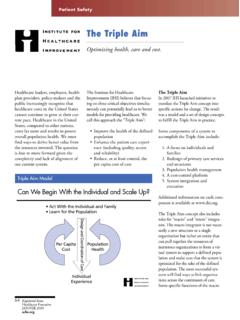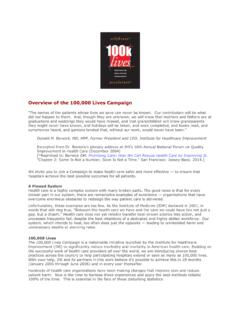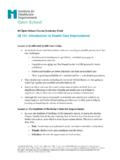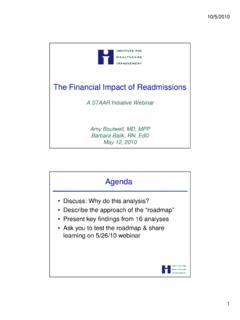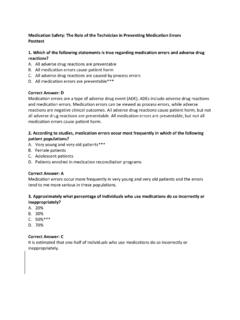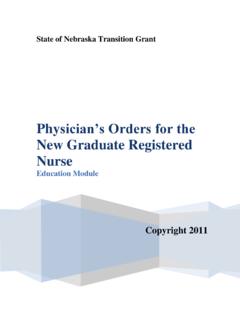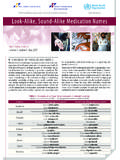Transcription of Safety Briefings - IHI
1 Copyright 2004 institute for Healthcare Improvement 1 institute for Healthcare Improvement Boston, Massachusetts, USA Safety Briefings A key element in improving patient Safety in any organization is fostering a culture of Safety : an environment with high awareness of Safety issues at all levels and with leadership that encourages and rewards reporting of Safety problems and concerns. In order to achieve a culture of Safety , awareness of potential problems must be part of daily operations 24 hours a day, 7 days a week not just when managers are present. Safety Briefings are a simple, easy-to-use tool that front-line staff can use to share information about potential Safety problems and concerns on a daily basis. Health care organizations use Safety Briefings to help increase staff awareness of patient Safety issues, create an environment in which staff share information without fear of reprisal, and integrate the reporting of medication Safety issues into daily work.
2 Over time, Safety Briefings help organizations create a culture of Safety , reduce the risk of medication errors, and improve quality of care. This tool contains: Background Using the Model for Improvement to Test Safety Briefings Instructions for Conducting Safety Briefings Safety briefing Data Collection Form Pre- and Post- Safety briefing Evaluation Copyright 2004 institute for Healthcare Improvement 2 Safety Briefings Background The concept of using Safety Briefings in patient care units, as described in this tool, originated with the institute for Healthcare Improvement s Idealized Design of the Medication System (IDMS) team. The team developed Safety Briefings to increase Safety awareness among front-line staff and to help develop a culture of Safety . Used in aviation and other industries, Safety Briefings incorporate discussions of Safety into the daily routine, 24 hours a day, 7 days a week. In connection with the institute for Healthcare Improvement s IDMS project, as well as Patient Safety Collaboratives, Summits, and other programs, hundreds of health care organizations have now tested this tool.
3 Originally tested on inpatient care units in hospitals, Safety Briefings are now being used in other hospital departments such as pharmacies and post-anesthesia care units, and in other health care settings, such as home health care and long-term care facilities. Copyright 2004 institute for Healthcare Improvement 3 Safety Briefings Using the Model for Improvement to Test Safety Briefings The IDMS team used the three questions in the Model for Improvement to develop a test of Safety Briefings : What do we want to accomplish? (Aims) Increase staff awareness of patient Safety issues Create an environment where staff freely share information about Safety issues without fear of reprisal Integrate Safety into the daily routine Change the culture How will we know that a change is an improvement? (Measures) Number of Safety issues identified by staff Amount of information shared among staff Number of near misses, , errors caught before reaching the patient, reported Number of patients raising Safety questions Number of errors prevented by patient questions Percentage of staff who perceive Safety Briefings as valuable What change can we make that will result in an improvement?
4 (Changes) Conduct Safety briefing on a patient care unit twice per shift. Copyright 2004 institute for Healthcare Improvement 4 Safety Briefings Lessons Learned As a result of the test, the IDMS team found that the following elements were critical to the success of Safety Briefings : Safety Briefings must be nonpunitive. Staff members feel comfortable sharing information during a Safety briefing only if there are assurances that the information would not be used punitively later on (as grounds for disciplinary action or in a performance appraisal, for example). Support from the unit manager for this is essential and should be expressed prior to testing the Safety briefing and reinforced repeatedly with staff. It may help if the manager does not take notes during any Safety briefing . Safety Briefings must be brief. The Safety briefing is designed to occur during the normal work shift and thus will take staff away from their routine duties.
5 Staff are likely to be concerned about the time taken away from work and patient care. For this reason, it is recommended that a time limit of 5 minutes be set and communicated to staff from the beginning. Monitoring the time during each Safety briefing is essential. Identify in advance a list of Safety issues for discussion. At the first few Safety Briefings , staff may not understand what types of issues to raise, or may be uncertain about the purpose of the briefing and how the information will be used later on. Develop a list of common Safety issues in advance, using evidence from published Safety alerts such as those from the Joint Commission on Accreditation of Healthcare Organizations (JCAHO) and the institute for Safe Medication Practices (ISMP), and discuss a few Safety issues from such sources until staff begin to identify their own issues for discussion. The Safety briefing Data Collection Form contains a list of common medication Safety issues for discussion.
6 Safety Briefings must be easy to use. The ultimate goal is for the briefing to become a tool that staff can use on their own on every shift, without a manager or other facilitator present to conduct it. As such, it must be easy for all staff to understand and use on their own. Safety Briefings must be applicable to all patient Safety issues. The sample Safety briefing data collection form refers to medication Safety issues only, as the first tests of the briefing were related only to medication Safety issues. Many other types of patient Safety issues exist (falls, equipment failures, infections, etc.) and this tool is designed so that these and other topics can be added to the briefing discussions. Copyright 2004 institute for Healthcare Improvement 5 Safety Briefings Instructions for Conducting Safety Briefings Getting Ready Identify a patient care unit for the first test of a Safety briefing . Choose one where the manager is receptive to testing changes and agrees with the nonpunitive approach of the briefing .
7 Meet with the manager to explain the concept and purpose of the briefing and to ask for support on the nonpunitive approach. Test the briefing on a small scale (for example, on the day shift for only one week). Decide who will conduct the test with the staff: the Unit Manager, the Patient Safety Officer, the Director of Quality Improvement, or a combination of these individuals. On the first few days of the test, someone must lead the discussion and explain the goals to the staff. Inform the staff in advance of the plans for the test. briefing : Start of Shift For the first briefing , convene all staff involved in patient care on that shift. Explain the purpose of the briefing , reinforcing the nonpunitive aspect and emphasizing the 5-minute time limit. Use the Safety briefing data collection form to start the discussion. If the staff do not have any Safety issues to discuss, use a few examples from the list of common Safety issues. Use the Safety briefing data collection form to note the length of the briefing and the number of issues raised by staff.
8 Survey the staff about their perception of the usefulness of the briefing , using the Pre- Safety briefing Evaluation. Inform the staff that everyone will reconvene near the end of the shift for a debriefing and ensure that everyone knows the time and location. Debriefing: End of Shift Reconvene the staff at the appointed time and place. Reinforce the nonpunitive aspect of the briefing . Ask staff if anyone encountered any medication Safety issues, experienced a near miss, or had a patient question medications during the shift. Collect data on the items listed in the data collection form. Copyright 2004 institute for Healthcare Improvement 6 Safety Briefings Ask staff for suggestions on how to improve the briefing (for example, find out if the times of day selected for the briefing and Debriefing are convenient for staff). Modify the plans as needed without altering the goals. Remind the staff of the plans for the next day s briefing .
9 Toward the end of the test, ask the staff how valuable the Briefings were. Sample questions may be found in the Post- Safety briefing Evaluation. After the test, review the data collected and share results with the staff. Determine whether to continue the Briefings and what modifications should be made. Spread the briefing to other shifts, patient care units, and departments. Copyright 2004 institute for Healthcare Improvement 7 Safety Briefings Tips from Organizations That Have Used Safety Briefings Many health care organizations have tested Safety Briefings and identified other ways to use them. Here are some suggestions based on what those organizations have learned: Make the frequency of the Safety Briefings appropriate. Patient care units vary in size of staff and number of patients. For some smaller units, a daily briefing may be too frequent, especially if the staff and patients present do not change frequently. Modify the frequency of the Briefings to a schedule that works best for each unit; they should be frequent enough to maintain a Safety culture, but not so frequent that staff view them as burdensome rather than helpful.
10 Spread the Safety Briefings to the entire care team and to other settings. Many organizations initially conducted Safety Briefings with nurses, and then expanded them to the entire care team, including physicians, therapists, and case managers. Other organizations initially conducted Safety Briefings on inpatient nursing units, but many spread their use to other patient care departments, such as pharmacies and post-anesthesia care units. Briefings should be spread throughout the organization and modified to fit the needs of each department. Use Safety Briefings to identify opportunities for improvement. Organizations can use the data collected during Safety Briefings to identify opportunities for improvement. For example, nursing staff may identify that they are receiving a lot of tablets that must be cut and split, increasing the risk of incorrect doses; if this information is shared with pharmacists, they can order tablets in the dosages that are needed, eliminating the need for splitting.
